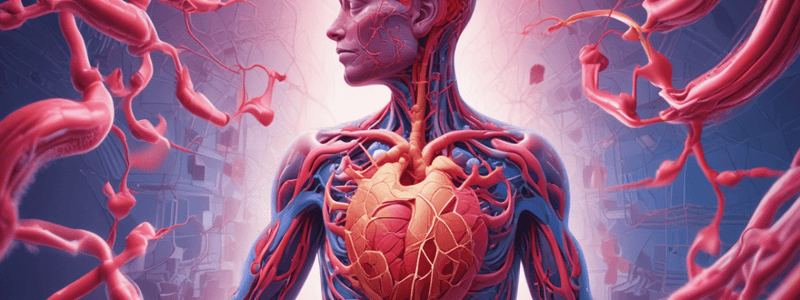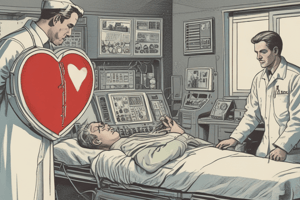Podcast
Questions and Answers
Which chamber of the heart collects deoxygenated blood from the entire body (except the lungs)?
Which chamber of the heart collects deoxygenated blood from the entire body (except the lungs)?
- Left ventricle
- Right ventricle
- Right atrium (correct)
- Left atrium
Which ventricle pumps deoxygenated blood to the lungs via the pulmonary artery?
Which ventricle pumps deoxygenated blood to the lungs via the pulmonary artery?
- Right ventricle (correct)
- Both ventricles
- Neither ventricle
- Left ventricle
Which atrium collects oxygenated blood from the capillary beds of the lungs through the pulmonary veins?
Which atrium collects oxygenated blood from the capillary beds of the lungs through the pulmonary veins?
- Both atria
- Left atrium (correct)
- Neither atrium
- Right atrium
Which ventricle pumps oxygenated blood through the aorta to the systemic circulation?
Which ventricle pumps oxygenated blood through the aorta to the systemic circulation?
In right-sided heart failure, what is the result of the right ventricle being unable to pump blood into the pulmonary artery?
In right-sided heart failure, what is the result of the right ventricle being unable to pump blood into the pulmonary artery?
In left-sided heart failure, what is the result of blood being backed into the left atrium and the pulmonary veins?
In left-sided heart failure, what is the result of blood being backed into the left atrium and the pulmonary veins?
Which type of blood vessel carries blood away from the heart?
Which type of blood vessel carries blood away from the heart?
Which type of blood vessel carries blood towards the heart?
Which type of blood vessel carries blood towards the heart?
Which type of heart defect is genetic and present at birth?
Which type of heart defect is genetic and present at birth?
What is the leading cause of acquired heart disease in children?
What is the leading cause of acquired heart disease in children?
Which heart defect is characterized by increased pulmonary blood flow and left-to-right shunt?
Which heart defect is characterized by increased pulmonary blood flow and left-to-right shunt?
Which heart defect is characterized by decreased pulmonary blood flow?
Which heart defect is characterized by decreased pulmonary blood flow?
Which heart disorder is caused by an inflammatory reaction to a Group A beta-hemolytic streptococcus infection?
Which heart disorder is caused by an inflammatory reaction to a Group A beta-hemolytic streptococcus infection?
Which heart disorder is characterized by a multisystem disease that affects the cardiovascular system and can lead to a coronary artery aneurysm?
Which heart disorder is characterized by a multisystem disease that affects the cardiovascular system and can lead to a coronary artery aneurysm?
Which type of heart defect is characterized by an obstruction to blood flow?
Which type of heart defect is characterized by an obstruction to blood flow?
What is the main difference between Rheumatic Heart Disease and Kawasaki Disease?
What is the main difference between Rheumatic Heart Disease and Kawasaki Disease?
What is a hallmark sign of patent ductus arteriosus (PDA) in children?
What is a hallmark sign of patent ductus arteriosus (PDA) in children?
Which of the following is a common sign of congestive heart failure (CHF) in children with PDA?
Which of the following is a common sign of congestive heart failure (CHF) in children with PDA?
Why is it important to monitor feeding tolerance and offer small, frequent feedings in infants and small children with PDA?
Why is it important to monitor feeding tolerance and offer small, frequent feedings in infants and small children with PDA?
Which of the following is a reason for monitoring urinary output in children with PDA?
Which of the following is a reason for monitoring urinary output in children with PDA?
Why is it important to avoid clustering care in children with PDA?
Why is it important to avoid clustering care in children with PDA?
What is the reason for monitoring thrombocytopenia (low platelet count) in children with PDA?
What is the reason for monitoring thrombocytopenia (low platelet count) in children with PDA?
Which of the following is a common sign of PDA in infants?
Which of the following is a common sign of PDA in infants?
Why are children with PDA at increased risk for bacterial endocarditis?
Why are children with PDA at increased risk for bacterial endocarditis?
What is the main cause of asthma according to the text?
What is the main cause of asthma according to the text?
Which of the following is NOT listed as a trigger for asthma in the text?
Which of the following is NOT listed as a trigger for asthma in the text?
What is the pathophysiology of asthma described in the text?
What is the pathophysiology of asthma described in the text?
What is used to measure the amount of air that can be forcefully exhaled in 1 second as mentioned in the text?
What is used to measure the amount of air that can be forcefully exhaled in 1 second as mentioned in the text?
Which type of medication is specifically mentioned as an anti-inflammatory agent for asthma in the text?
Which type of medication is specifically mentioned as an anti-inflammatory agent for asthma in the text?
What is a common symptom of asthma according to the text?
What is a common symptom of asthma according to the text?
Which diagnostic test exposes patients to methacholine, cold air, or histamine?
Which diagnostic test exposes patients to methacholine, cold air, or histamine?
What is the most common cause of epiglottitis?
What is the most common cause of epiglottitis?
Which position does a child with epiglottitis typically assume to maximize their airway?
Which position does a child with epiglottitis typically assume to maximize their airway?
What do ABGs reveal in patients with asthma according to the text?
What do ABGs reveal in patients with asthma according to the text?
What type of agonist is used as a bronchodilator in asthma treatment?
What type of agonist is used as a bronchodilator in asthma treatment?
What is a key contraindication when suspecting epiglottitis during diagnosis?
What is a key contraindication when suspecting epiglottitis during diagnosis?
Which of the following symptoms is NOT associated with epiglottitis?
Which of the following symptoms is NOT associated with epiglottitis?
Why should inspection of the oropharynx be avoided in suspected cases of epiglottitis?
Why should inspection of the oropharynx be avoided in suspected cases of epiglottitis?
What is the recommended precaution for isolation when dealing with a patient having epiglottitis?
What is the recommended precaution for isolation when dealing with a patient having epiglottitis?
What is crucial to have available when managing a patient with suspected epiglottitis?
What is crucial to have available when managing a patient with suspected epiglottitis?





